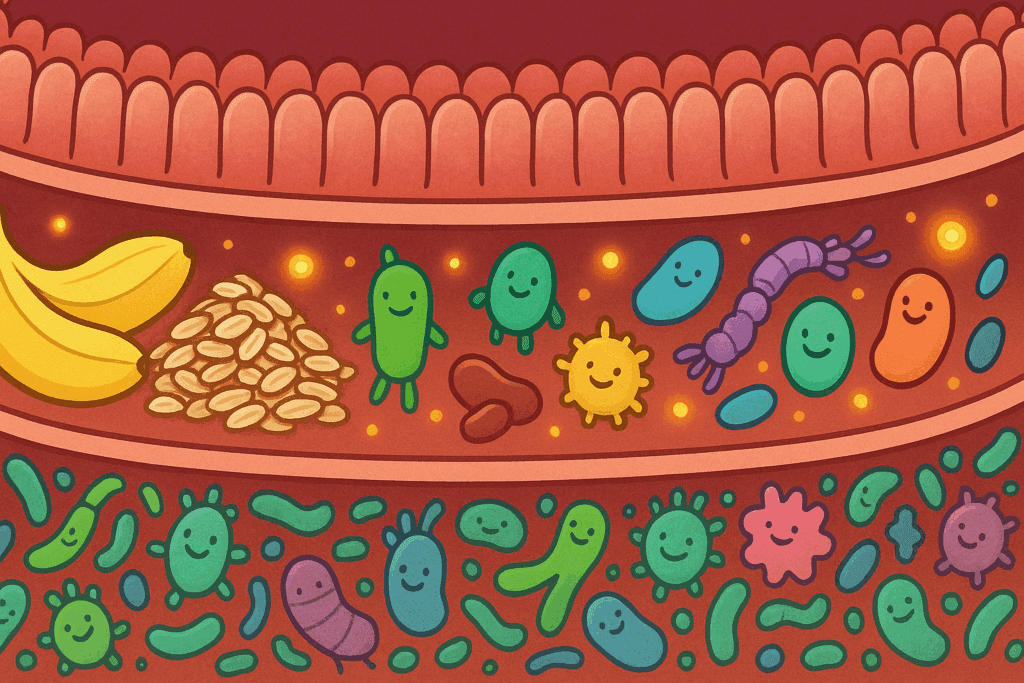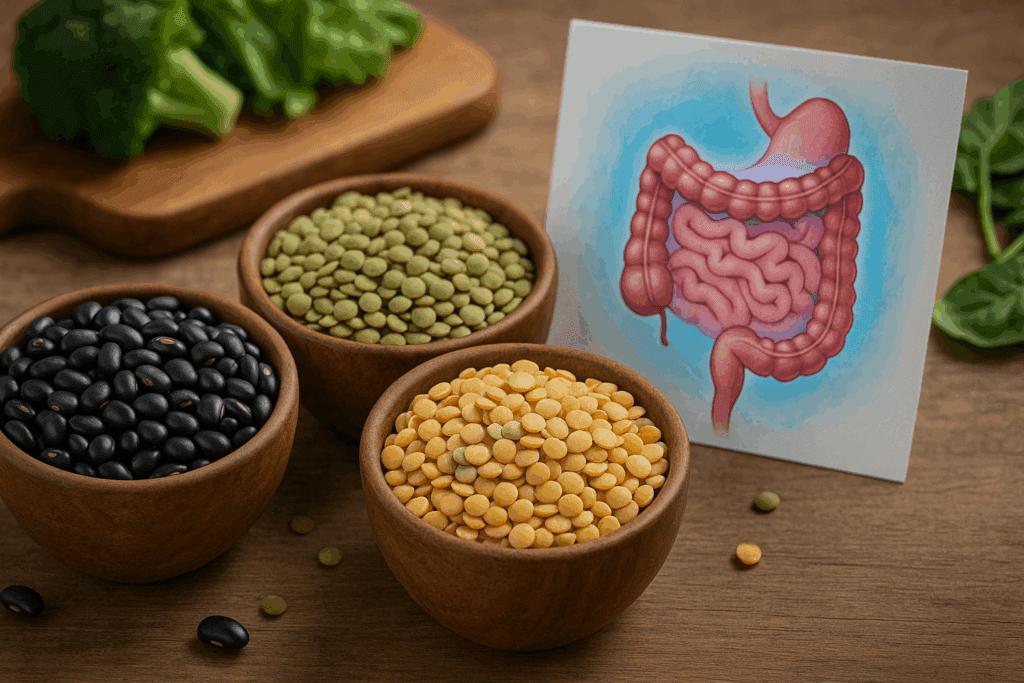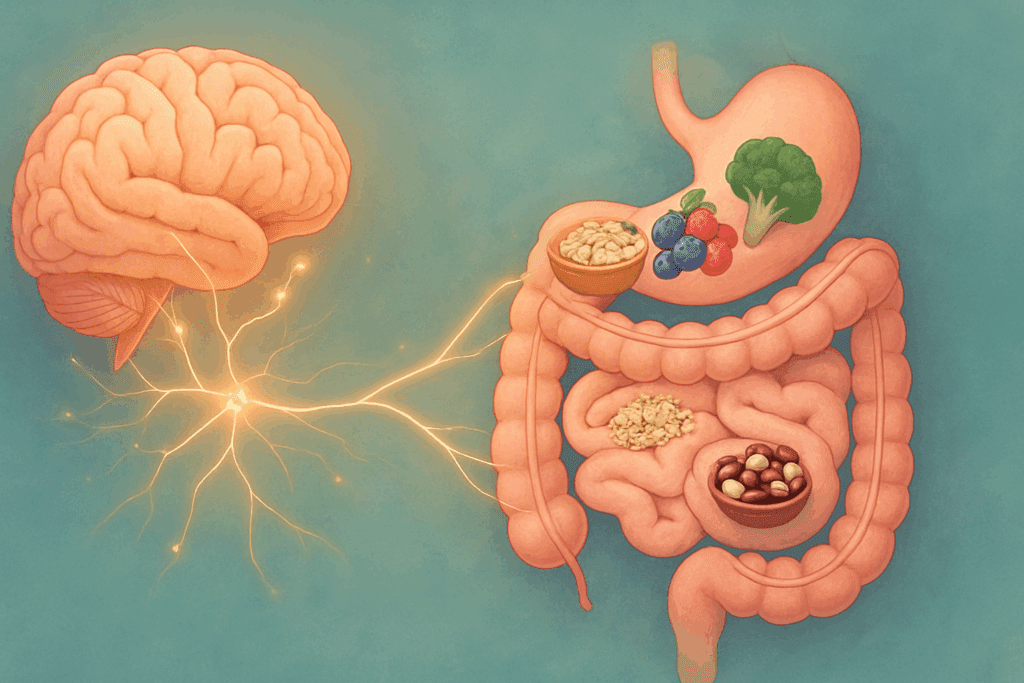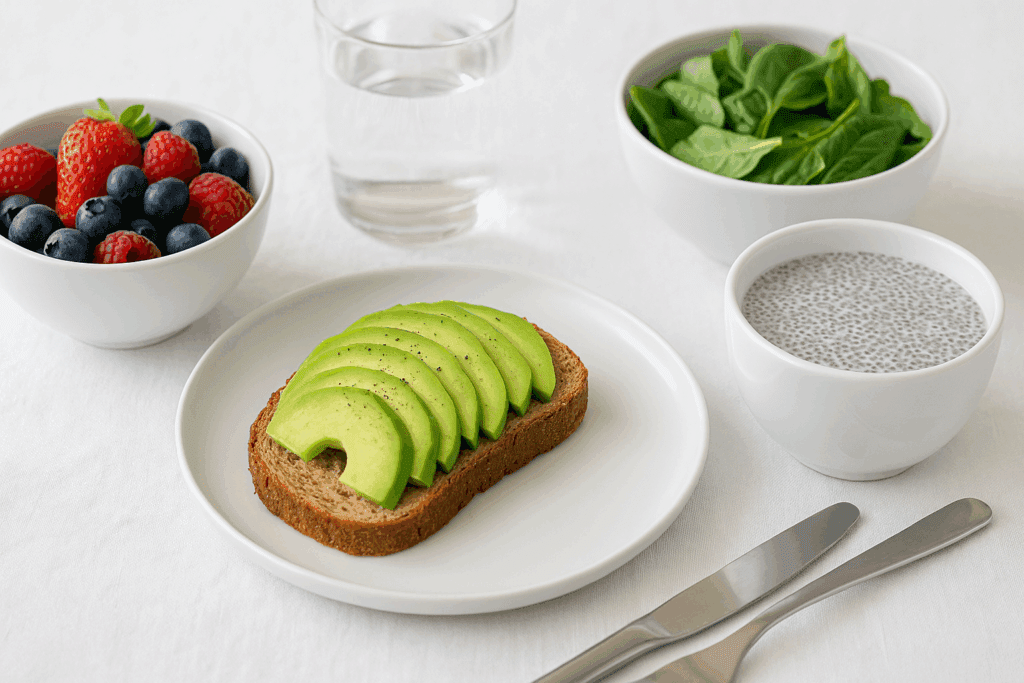A growing body of research highlights the critical role that dietary fiber plays in maintaining digestive wellness, regulating blood sugar, and supporting long-term health outcomes. In particular, high fiber carbs offer a dual advantage: they provide sustained energy while also feeding beneficial gut bacteria. For individuals seeking to improve their gastrointestinal health, understanding the nature of high fiber carbohydrates, their sources, and how to integrate them into daily nutrition is essential. As we explore this topic, we will uncover not only the biological significance of fiber-rich foods but also their broader implications for holistic health strategies, including their interactions with probiotics, glycemic control, and metabolic support.
You may also like: The Ultimate Guide to Gut Healthy Meals: Best Meals for Gut Health and Nourishing Recipes You’ll Love

Understanding High Fiber Carbohydrates and Their Role in Digestive Health
Carbohydrates are often viewed through the lens of sugar spikes and weight gain, but this perception fails to differentiate between simple, refined carbohydrates and their more complex, fiber-rich counterparts. High fiber carbohydrates, such as legumes, whole grains, and certain vegetables, resist rapid digestion and instead pass slowly through the gastrointestinal tract. This slower process is fundamental to stable blood glucose levels and extended satiety, two factors that can aid in managing body weight and reducing the risk of metabolic disorders. Fiber is not a single entity but exists in soluble and insoluble forms, both of which offer distinct benefits to the gut.
Soluble fiber dissolves in water and forms a gel-like substance in the gut, which helps lower cholesterol levels and moderate glucose absorption. Insoluble fiber, on the other hand, adds bulk to the stool and accelerates its passage through the digestive system, thereby preventing constipation and promoting regularity. This dichotomy enables high fiber carbs to simultaneously cleanse the colon and nurture the microbiota residing there. The importance of maintaining a thriving community of gut bacteria cannot be overstated, as these microorganisms contribute to immune function, mental well-being, and inflammation control. In short, incorporating high fiber carbs into a daily diet is not merely a digestive aid but a cornerstone of holistic well-being.

The Science Behind High Fiber Carbs and Gut Microbiome Synergy
The human gut harbors trillions of microbes that influence everything from mood regulation to nutrient absorption. These microbial communities, collectively referred to as the gut microbiome, thrive on specific types of fiber known as prebiotics. High fiber carbohydrates are among the most effective natural prebiotics, especially those found in beans, lentils, oats, bananas, and Jerusalem artichokes. When these fibers reach the large intestine undigested, they become fermentable substrates for beneficial bacteria like Bifidobacteria and Lactobacillus. The fermentation process yields short-chain fatty acids (SCFAs), such as butyrate, acetate, and propionate, which play a key role in reducing inflammation, improving intestinal barrier function, and protecting against chronic diseases.
This biochemical interplay highlights why fiber is so crucial in modulating gut health. Not only does fiber nourish gut flora, but it also directly influences the metabolic byproducts that shape immune responses and neurological function. In recent years, scientists have discovered links between SCFAs and reduced risk of conditions such as irritable bowel syndrome (IBS), colorectal cancer, and even anxiety disorders. Therefore, the strategic inclusion of high fiber carbs in the diet serves as a natural intervention point to optimize gut microbiome diversity and resilience.
Building a Balanced Diet Around High Fiber Carbs: Practical Strategies
Incorporating high fiber carbs into your daily nutrition doesn’t require a radical dietary overhaul. Small, consistent changes can produce meaningful results. Begin by replacing refined carbohydrates such as white rice or pasta with their whole-grain counterparts like brown rice, quinoa, or barley. Introduce fiber-dense legumes such as black beans, chickpeas, and lentils into soups, salads, and side dishes. These not only add texture and flavor but also significantly increase dietary fiber content. For breakfast, consider swapping sugary cereals for steel-cut oats or chia pudding topped with berries and nuts. These choices are excellent examples of high fiber low sugar foods that stabilize blood glucose levels and promote satiety.
Cooking methods also influence fiber retention. Steaming vegetables like broccoli, carrots, and sweet potatoes preserves more fiber compared to boiling. Furthermore, maintaining the skin on fruits and vegetables, such as apples or cucumbers, maximizes insoluble fiber intake. To meet the recommended daily intake of 25 to 38 grams of fiber, dietary variety is crucial. A well-rounded approach that includes grains, legumes, fruits, and vegetables ensures a broad spectrum of fiber types and phytonutrients, each contributing uniquely to gut health.

High Fiber Carbs List: Nutrient-Dense Foods That Support the Gut
Understanding which foods are rich in dietary fiber is the first step toward improving gut health. Among the most effective sources are legumes, which include the beans with highest fiber content, such as navy beans, kidney beans, and adzuki beans. These provide not only insoluble fiber but also valuable protein and micronutrients like iron and folate. Whole grains also feature prominently on any high fiber carbs list. Foods such as bulgur, millet, amaranth, and farro offer complex carbohydrates that release energy slowly and feed gut bacteria over an extended period.
Vegetables such as Brussels sprouts, artichokes, and leafy greens are particularly high in fiber and low in sugar, making them ideal for individuals seeking high fiber low sugar foods. Fruits like raspberries, pears with skin, and avocados strike a similar balance, delivering antioxidants alongside their fiber content. Additionally, seeds like flax, chia, and psyllium husk offer concentrated fiber doses in small serving sizes, making them ideal for boosting fiber intake in smoothies or baked goods. A comprehensive high fiber carbs list is not merely a dietary tool but a blueprint for nourishing the entire digestive ecosystem.

Why High Fiber Low Carb Food Can Still Be Gut-Friendly
There is a growing interest in low-carb diets for weight management and metabolic health. However, some versions of these diets risk reducing fiber intake by limiting carbohydrate sources indiscriminately. It is entirely possible to pursue a high fiber low carb food strategy that maintains digestive integrity while supporting glycemic control. Cruciferous vegetables like cauliflower, broccoli, and kale are naturally low in carbs but high in both insoluble and soluble fiber. These options support bowel regularity and provide sulfur-containing compounds that enhance detoxification pathways in the liver.
Nuts and seeds are another powerful category of high fiber low carb foods. Almonds, walnuts, and sunflower seeds not only provide healthy fats but also contribute substantial fiber that supports microbial diversity. Likewise, berries such as blackberries and strawberries are low in sugar yet rich in polyphenols and fiber, making them ideal additions to a low-carb, high-fiber regimen. Including these foods bridges the gap between carbohydrate restriction and gut health promotion, highlighting that fiber can remain a priority even in a lower-carb lifestyle.
The Role of Beans with Highest Fiber in Gut Integrity and Inflammation
Among all plant-based sources of dietary fiber, beans deserve special recognition. The beans with highest fiber are not only nutritional powerhouses but also potent modulators of gut health. Black beans, lentils, and split peas provide between 13 to 16 grams of fiber per cup, covering a substantial portion of the recommended daily intake. These legumes contain resistant starches and oligosaccharides that resist digestion in the small intestine and reach the colon intact. There, they undergo fermentation, producing SCFAs that strengthen the gut barrier and regulate immune function.
Moreover, beans supply polyphenols, which act as antioxidants and further support a healthy inflammatory balance in the gut. Chronic inflammation is a key driver of many gastrointestinal and systemic conditions, including leaky gut syndrome, ulcerative colitis, and even autoimmune disease. The consumption of fiber-rich beans has been associated with reductions in markers like C-reactive protein (CRP), suggesting their potential as dietary interventions for inflammation control. Including a variety of beans in weekly meals not only diversifies the gut microbiota but also fortifies intestinal resilience against stressors.

High Fiber Carbs and the Gut-Brain Connection
Emerging research in the field of nutritional psychiatry has drawn attention to the gut-brain axis—the bidirectional communication pathway between the enteric nervous system and the central nervous system. High fiber carbs contribute significantly to the function of this axis by influencing the microbiome, which in turn affects the production of neurotransmitters like serotonin and dopamine. Approximately 90% of the body’s serotonin is produced in the gut, and its synthesis is closely tied to microbial activity. Therefore, fiber intake has indirect but measurable effects on mood, cognition, and stress regulation.
SCFAs generated by fiber fermentation serve as signaling molecules that impact neuroinflammation, blood-brain barrier integrity, and vagus nerve stimulation. Clinical studies have noted that increased fiber intake is associated with lower rates of depression and anxiety, possibly due to these neurochemical changes. For individuals experiencing mood disorders or cognitive decline, dietary interventions that include high fiber carbohydrates may offer complementary benefits alongside traditional treatments. This insight adds another dimension to the value of high fiber carbs, extending their relevance beyond the gut and into broader mental health territory.
How to Transition to a High Fiber Carbohydrates Diet Without Discomfort
Suddenly increasing fiber intake can cause gastrointestinal discomfort such as bloating, gas, and abdominal cramping. To avoid these effects, a gradual transition to a diet centered around high fiber carbohydrates is recommended. Start by increasing fiber by 5 grams per day over the course of a week while simultaneously boosting water intake. Hydration is critical, as fiber needs water to form bulk and move smoothly through the digestive tract. Without adequate fluid, increased fiber can actually lead to constipation.
Another useful strategy is to vary fiber sources. Rotating between different types of beans, grains, fruits, and vegetables prevents the overconsumption of specific fermentable fibers that might cause discomfort in sensitive individuals. Cooking beans thoroughly and soaking them beforehand reduces compounds that contribute to gas production, such as phytic acid and raffinose. Similarly, lightly steaming vegetables can make their fiber content more tolerable while preserving their nutritional integrity. Through careful planning and moderation, the body can adapt to a higher fiber load while minimizing side effects.

Evaluating High Fiber Low Sugar Foods for Blood Sugar Balance
One of the standout benefits of high fiber carbohydrates is their role in regulating blood glucose. Unlike simple carbs that lead to rapid spikes in blood sugar, fiber-rich foods slow the absorption of glucose and promote insulin sensitivity. This is particularly beneficial for individuals with diabetes, prediabetes, or metabolic syndrome. Choosing high fiber low sugar foods, such as leafy greens, avocado, and berries, helps stabilize blood sugar without compromising on nutrient density.
Many of these foods also contain magnesium, chromium, and other minerals involved in glucose metabolism. Avocados, for instance, provide a rare combination of soluble fiber and healthy monounsaturated fats that reduce inflammation and improve insulin signaling. Whole grains like quinoa and buckwheat not only offer fiber but also contain resistant starches that are particularly beneficial for long-term glycemic control. These properties make high fiber carbs an integral part of any dietary protocol aimed at managing blood sugar and preventing complications.
The Lasting Impact of High Fiber Carbs on Overall Wellness
While the digestive benefits of fiber are well established, its effects extend into nearly every domain of health. Cardiovascular wellness, for instance, is significantly influenced by fiber intake, with soluble fibers reducing LDL cholesterol and improving lipid profiles. High fiber diets are also associated with a lower risk of certain cancers, particularly colorectal cancer, due to the protective action of SCFAs and increased fecal bulk. In addition, fiber plays a crucial role in weight regulation by enhancing satiety hormones and reducing overall caloric intake without increasing hunger.
From a preventative health perspective, high fiber carbohydrates can serve as a dietary cornerstone for reducing the risk of chronic disease. Their ability to improve gut microbiome diversity has downstream effects on immune function, nutrient absorption, and even hormonal balance. For athletes and active individuals, fiber helps maintain energy stability during performance and aids in recovery by reducing oxidative stress. The versatility of fiber-rich foods makes them suitable across age groups and lifestyles, providing universal value regardless of specific health goals.
Frequently Asked Questions: Expert Insights on High Fiber Carbs and Gut Health
What are some lesser-known benefits of high fiber carbs for athletic recovery?
While many athletes focus on protein for recovery, high fiber carbs offer unique advantages post-exercise. These carbohydrates help replenish glycogen stores gradually, which supports sustained muscle recovery without sudden glucose spikes. Moreover, high fiber carbohydrates encourage anti-inflammatory responses through the production of short-chain fatty acids (SCFAs), which are beneficial after intense training sessions. Certain foods like lentils and steel-cut oats also supply magnesium and B vitamins that contribute to muscle function and cellular repair. For endurance athletes, integrating high fiber carbs into recovery meals may also aid in stabilizing appetite hormones, promoting consistent energy regulation throughout the day.
How do high fiber low sugar foods influence hormonal balance in women?
High fiber low sugar foods such as chia seeds, raspberries, and cruciferous vegetables can positively influence estrogen metabolism and insulin sensitivity. These foods slow down the absorption of sugars, preventing erratic spikes in insulin that may contribute to conditions like polycystic ovarian syndrome (PCOS). Additionally, fiber supports the excretion of excess estrogen through the digestive tract, thereby contributing to hormonal equilibrium. This mechanism is especially helpful during perimenopausal or premenstrual phases, when hormonal fluctuations are more pronounced. By favoring high fiber low sugar foods, women can help modulate endocrine function in a natural and sustainable way.
Is there a psychological benefit to regularly consuming high fiber carbohydrates?
Yes, there is emerging evidence that high fiber carbohydrates contribute to improved mood and mental clarity. One mechanism involves the gut-brain axis, where the fermentation of fiber supports the production of neurotransmitters like serotonin. Another pathway is through reduced systemic inflammation, which has been linked to depression and cognitive fatigue. People who consume a diet rich in high fiber carbs often report better emotional regulation, potentially due to more stable blood glucose levels and a balanced gut microbiota. Long-term adherence to a fiber-rich diet may reduce the risk of developing mood disorders, especially when combined with other lifestyle factors like exercise and sleep hygiene.
What is the best way to travel while maintaining a diet high in fiber carbs?
Travel often disrupts regular eating habits, but maintaining a diet rich in high fiber carbs while on the go is entirely feasible with planning. Packing shelf-stable snacks such as roasted chickpeas, high-fiber granola bars, or vacuum-sealed cooked lentils can keep your fiber intake steady. Many airports and convenience stores now carry options like edamame, whole-grain wraps, or quinoa salads. When dining out, opt for side dishes like black beans, sweet potatoes, or brown rice. Staying hydrated is equally important while traveling with a high fiber diet to prevent digestive discomfort.
High Fiber Carbs List: What Uncommon Foods Belong on It?
Beyond the usual suspects like whole grains and legumes, there are several overlooked foods that belong on a well-rounded high fiber carbs list. Jerusalem artichokes, for example, are rich in inulin, a prebiotic fiber that boosts gut flora diversity. Green plantains and cooked-and-cooled potatoes contain resistant starch, which acts similarly to soluble fiber in the colon. Ancient grains like freekeh and teff not only provide high fiber but also essential amino acids. Even certain mushrooms, particularly maitake and shiitake, contribute modest amounts of fiber while offering additional immune benefits. Including these in your high fiber carbs list expands nutrient variety and encourages a more robust microbiome.
How do high fiber low carb food choices fit into ketogenic or low-glycemic diets?
High fiber low carb food options such as flaxseeds, cauliflower, and avocado are excellent for those following low-glycemic or ketogenic diets. These foods contribute to total fiber intake without significantly affecting net carb count, which is essential for staying in ketosis. Moreover, they improve digestive regularity, which can sometimes be compromised in low-carb diets that are too meat-heavy or fat-centric. They also offer anti-inflammatory nutrients like omega-3 fatty acids and polyphenols, complementing the metabolic goals of low-glycemic approaches. By strategically including these foods, individuals can meet their fiber needs while adhering to a low carbohydrate threshold.
Beans with Highest Fiber: Do Different Cooking Methods Change Their Benefits?
Cooking methods can indeed influence the fiber integrity and nutritional value of the beans with highest fiber content. While soaking and boiling are traditional methods, pressure cooking preserves more resistant starch and reduces compounds that cause bloating. For instance, adzuki and black beans retain more soluble fiber when gently simmered rather than rapidly boiled. Sprouting beans before cooking can also increase their digestibility and slightly enhance fiber bioavailability. However, overcooking beans into a mushy consistency may break down some of their structural fiber, reducing their bulking ability. A balance between tenderness and texture preserves both culinary appeal and gut-health benefits.
How do high fiber carbs affect children’s gut development and immunity?
Introducing high fiber carbohydrates early in childhood supports healthy gut flora development and strengthens immune function. Foods like mashed lentils, pureed peas, or oatmeal can be integrated into a child’s diet starting at the appropriate age, based on pediatric guidance. Fiber fosters microbial diversity, which is crucial for training the immune system and reducing the likelihood of allergies or autoimmune issues. Moreover, the SCFAs produced from fiber fermentation help reinforce the intestinal lining, making it less permeable to pathogens. Creating positive associations with these foods early on lays the groundwork for lifelong digestive resilience and immune competence.
High Fiber Carbs and Social Eating: How to Stay on Track Without Being Restrictive
Navigating social events can be challenging when trying to maintain a diet centered on high fiber carbs, but flexibility is key. Many cultural cuisines naturally feature high fiber carbohydrates, such as lentil dals, bean stews, or tabbouleh made with bulgur wheat. When attending gatherings, subtly prioritize dishes that include legumes, whole grains, or fiber-rich vegetables. If you’re contributing a dish, consider bringing a fiber-forward option like a quinoa salad with chickpeas and herbs. Practicing mindful eating—focusing on flavors and fullness cues—also helps maintain balance without creating a sense of deprivation.
How Are Researchers Expanding the Functional Uses of High Fiber Carbohydrates in Medicine?
Scientists are now exploring the use of high fiber carbohydrates in medical nutrition therapy, particularly for conditions like irritable bowel syndrome (IBS), ulcerative colitis, and metabolic syndrome. New research is evaluating specific types of fermentable fibers that can modulate inflammation at the gene expression level. Some clinical trials are examining personalized prebiotic formulations derived from beans with highest fiber, tailored to an individual’s microbiome profile. Others are investigating how high fiber low sugar foods can regulate lipid profiles and improve insulin sensitivity beyond traditional pharmacotherapy. As these studies progress, we may see the emergence of targeted fiber blends prescribed alongside conventional treatments for chronic disease management.
High Fiber Carbs in the Future of Personalized Nutrition
The next frontier of nutrition science may lie in matching high fiber carbs to a person’s genetic and microbiome blueprint. Already, companies are offering personalized dietary plans that assess an individual’s response to specific fibers using stool analysis and DNA sequencing. This approach aims to optimize fiber intake not just for general wellness but to address individual susceptibilities to inflammation, digestive disorders, and even neurological issues. Imagine a future where your high fiber carbs list is as tailored as your prescription medications, crafted to unlock your unique potential for health and longevity. Such innovations represent a transformative leap from one-size-fits-all advice to dynamic, data-driven nutrition strategies.
Conclusion: Embracing High Fiber Carbs for Lifelong Gut and Metabolic Health
Incorporating high fiber carbs into your diet is not just a trend or a checkbox on a nutrition label—it is a foundational step toward building a resilient and vibrant digestive ecosystem. As science continues to unravel the interconnectedness of the gut with other bodily systems, the importance of dietary fiber only becomes more pronounced. From fueling beneficial gut microbes and producing anti-inflammatory compounds to balancing blood sugar and supporting mental well-being, high fiber carbohydrates serve as a linchpin in holistic health.
The transition to a fiber-rich lifestyle does not require dramatic changes but thoughtful choices made consistently over time. Whether through legumes, whole grains, or high fiber low sugar foods, every meal presents an opportunity to nourish your microbiome and safeguard your health. Armed with a knowledge of high fiber carbs list and practical cooking strategies, individuals can take charge of their well-being in an informed, sustainable, and satisfying way. Ultimately, high fiber carbs are not just gut-friendly—they are life-enhancing.

